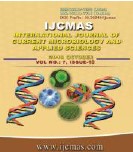


 National Academy of Agricultural Sciences (NAAS)
National Academy of Agricultural Sciences (NAAS)

|
PRINT ISSN : 2319-7692
Online ISSN : 2319-7706 Issues : 12 per year Publisher : Excellent Publishers Email : editorijcmas@gmail.com / submit@ijcmas.com Editor-in-chief: Dr.M.Prakash Index Copernicus ICV 2018: 95.39 NAAS RATING 2020: 5.38 |
Pleurotus mushroom, generally referred to as ‘Oyster mushroom or Dhingri’ in India is relatively new to the mushroom industry. In India, Odisha is a leading state in terms of oyster mushroom production. The condition in most of agro-climatic situation in Odisha are suitable for growing oyster mushroom from month of July to February comprising of the rainy and winter season. Pleurotus pulmonarius is a potential protein source especially in developing countries, besides having minerals and vitamins. Besides its edibility it has also got pharmaceutical properties. Hence, Pleurotus pulmonarius could well be incorporated in to the mushroom farming system during winter season besides the ruling species, as this species was not in cultivation earlier. Studies on growth pattern and fruit body characteristics revealed that the mycelium P. pulmonarius was dense strandy on PDA medium with pale white colony colour. The pileus diameter, stipe length and stipe thickness varied between 5.2-10.0, 2.5-5.5 and 0.9-2.3cm respectively. The margin of the fruit body was found to be wavy with pale white pileus colour. Among the nine substrates evaluated for their yield potential, superiority of paddy straw was established in terms of realization of biological efficiency (99.30%). Sugarcane bagasse, rice bran and saw dust were found inferior with biological efficiency of 61.07, 70.20 and 77.40% respectively. The biological efficiency varied within 61.07% on sugarcane bagasse to 99.30% on paddy straw. The biological efficiency was numerically highest (100.17%) on the 1st January, 2016 spawning which was statistically equal to 1st and 16th December, 2015 spawning (99.15 and 99.87%) among the eight spawning dates evaluated during the winter season at 15 days interval each. The results thus revealed that December and January spawning were appropriate in realizing superior yields out of P. pulmonarius.
 |
 |
 |
 |
 |